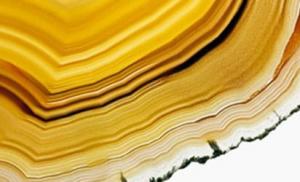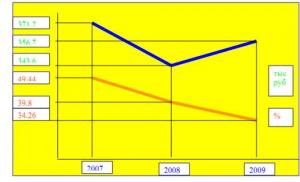The Indigirka River and its seven wonderful places.
The river is fed by mixed water: rain (50–65%), snow (20–40%) and underground (5–10%).
The average long-term water flow at the Vorontsovo hydrological station (350 km from the sea) is 1600 m 3 /s (the annual flow volume is 50.498 km 3).
The river is characterized by the East Siberian type of water regime: spring-summer flood, summer-autumn flood period, short low water in autumn and low winter low water. The flood occurs in May–June for 55 days; it accounts for 46% of the river's annual flow. Average consumption
flood 7,850 m 3 /s, maximum river flow - from 3360 to 11,700 m 3 /s. The second high-water phase is associated with rain floods, forming a single wave of increased runoff. The maximum water flow during floods varies from 1500 to 11100 m 3 /s.
The water flow during the flood period is 18% of the year. The duration of individual floods is on average nine days. The minimum water flow during the open channel period (638 m 3 /s) is observed before freeze-up. During winter low water in the lower reaches, water flows decrease to 6.8 m 3 /s. At the beginning of June, a sharp rise in water levels begins: 51–56 cm/day in the middle reaches, 7–14 cm/day in the delta. Down the river, the height of the spring rise in water levels decreases: c. Vorontsovo (350 km from the sea) – 8.8 m, maximum 11.1 m, village. Chokurdakh (187 km from the sea) 7.5 m and 8.9 m, at the top of the delta (130 km from the sea) - 4–5 m, near the village. Tabor (24 km from the sea) - 2.6 m and 3.2 m, on Nemkova Island (0 km) - 1.1 m and 1.6 m. Level rise during congestion is 1–1.5 m. the decline of the flood wave is superimposed by rain floods. During the summer-autumn flood period, levels rise near the village. Vorontsovo reaches 1.4 m (maximum 4.5 m), near the village. Chokurdakh 1.4 m (2.8 m), near the village. Tabor - up to 0.5 m (1.2 m), near Nemkova Island - 0.4 m (1.05 m). Tides at the estuary coastal area reach 30 cm; at Nemkova Island - 5–7 cm. Surge fluctuations in level (at the seaside 1.5–2 m) spread during low-water periods 50–60 km from the sea, sometimes above the village. Chokurdakh (187 km from the sea).
The average discharge of suspended sediments near the village. Vorontsovo - 372 kg/s, annual sediment runoff is 11.7 million tons. Average long-term water turbidity in the lower reaches is 231 g/m3, during floods - about 300 g/m3, during rain floods - 200–300 g/m3 , in winter - from 10–12 to less than 3 g/m3.
In the upper reaches of the Indigirka there is a mountainous and semi-mountainous (59% of the length) river, the bed is pebbly, there are many stone ledges (shivers) at the river bottom. When crossing the Chemalginsky ridge, the river flows in a deep gorge and forms rapids (the largest is Busika). Below the river mouth The Momo Indigirka crosses the Momo-Selennyakh depression, becomes a flat river, the channel branches into two or three equal branches.
There are frequent rock outcrops in the riverbed. When crossing the Momsky ridge, the Indigirka again becomes a semi-mountain river with rapids and rifts. The width of the channel is 50–80 m. Below the village. The Krest-Major Indigirka finally becomes a flat river, pebble deposits are replaced by sand. In the Abyi lowland, the river bed is winding; in the Yana-Indigirskaya lowland, a straight channel with a width of 350–500 m predominates. In the lower reaches, the river meanders, forming steep bends; floodplain branches up to several tens of kilometers long are developed. The width of the river is 600–800 m, the depth at the riffles during low-water periods is about 2 m. Along the main banks the channel is relatively straight, unbranched (near Olenegorsk, Chokurdakh). The delta begins 130 km from the sea. The river is divided into two main branches - the Russko-Ustinskaya and Srednyaya channels. When the branches exit to the estuarine coastal zone, there are numerous shallow-water mouth bars. The rate of protrusion of the sea edge of the delta into the sea is insignificant.
The waters of Indigirka are characterized by low mineralization and hydrocarbonate composition, with a predominance of calcium and sodium cations. Water mineralization in the spring in the upper reaches is 20–50 mg/l, in the lower reaches – 40–70 mg/s, during the period of summer floods it varies from 40–65 to 50–85 mg/l, respectively. The long-term average ion flow at the g.p. Vorontsovo (350 km from the sea) is 3.040 million tons/year. Economic activity in the Indigirka basin is limited to fishing and reindeer herding, and the collection of mammoth ivory. The Indigirka is rich in fish; at the mouth there is a fishery for vendace, broad whitefish, muksun, nelma, omul, and whitefish. Gold is mined in the basin. Water intake – 0.008 km 3 /year, discharge volume Wastewater
Indigirka is the only transport route in the region. Navigation - from the mouth of the river. Momy (1154 km from the sea), in the delta - along the Srednyaya branch, entry into which from the sea is limited by the mouth bar with depths during surges of 0.5–0.6 m. Periodic navigation is carried out along the Russko-Ustinskaya channel to the village. Russian Ustye. Main piers: Khonuu, Druzhina, Olenegorsk, Chokurdakh, Tabor, Russkoye Ustye. In 1974–1975 a canal 7 km long, 40 m wide, and up to 2.5 m deep was built on the Indigirka bar. Its construction led to increased penetration of salt water sea waters into the river.
The town and settlements of Oymyakon, Ust-Nera, Khonuu, Belaya Gora, and Chokurdakh are located on Indigirka. Oymyakon is the famous pole of cold; It is considered the coldest point in the Northern Hemisphere and the coldest populated area on Earth.
V.N. Korotaev, R.S. Chalov
The Indigirka River flows in the northeast of Siberia, through the territory of Yakutia. The name of the river comes from the Even family name Indigir - “people of the Indi clan”. Russian explorers of the 17th century. they pronounced this name as Indigirka - just like the names of other large Siberian rivers: Kureika, Tunguska, Kamchatka.
The Indigirka is formed by the confluence of the Khastakh and Taryn-Yuryakh rivers, in the upper reaches it flows along the Oymyakon plateau, cuts through the Chersky ridge along a narrow deep valley, in the lower reaches it flows along the Yana-Indigirka lowland. The riverbed of the Indigirka is very winding. The Indigirka is divided into two sections according to the structure of the valley and channel, as well as the speed of the current: the upper mountain (length 640 km) and the lower plain (length 1086 km).
When it flows into 130 km from its mouth, the Indigirka breaks into branches (Russkoye estuary, Sredniy and Kolyma), forming a delta with an area of 5.5 thousand km 2.
Almost half of the annual flow occurs during the flood period in May - July. Due to permafrost rocks along which the river flows, it is characterized by the formation of giant aufeis-taryns, and in winter time The Indigirka River in its lower reaches is completely frozen over.
Since the river is filled with rapids and rifts in many places, navigation along the Indigirka is possible only in the middle and lower reaches, from the confluence of the Moma River (406 km).
Compared to other rivers of North-Eastern Siberia, the Indigirka is not rich in fish, but what is there is of valuable species: sterlet, burbot, shooting range, muksun, peled, vendace, broad white salmon, nelma, omul, whitefish, and at the mouth of the river there is flounder.
The Indigirka basin is a famous gold mining area.
“All the rifts, and the rifts...” - this line from the song of the bard Alexander Gorodnitsky perfectly describes the nature of the bed of the Indigirka River.
The Indigirka flows from the southern to the northern border, crossing four geographical zones(from south to north): taiga forests, forest-tundra, tundra and arctic desert.
It was possible to study the bed of the Indigirka in detail only in 1926 by the expedition of the Soviet geologist and future academician Sergei Vladimirovich Obruchev (1891-1965), the son of the famous traveler and explorer Vladimir Afanasyevich Obruchev (1863-1956). In 1926-1935 S. Obruchev studied the Indigirka basin and for the first time established that there were industrial reserves of gold there. S. Obruchev continued and completed a large study mountain system in the Indigirka basin, begun by I. D. Chersky (1845-1892), and named it after the discoverer - the Chersky Ridge.
Currently, Indigirka remains one of the main water transport arteries in the North-East of Russia. On its shore is North Pole cold - Oymyakon village. In 1933, a temperature of -67.7°C was recorded here. True, a number of experts consider Verkhoyansk to be the pole of cold.
Another less famous attraction of Indigirka is the abandoned city of Zashiversk. It was founded in 1639, in 1783-1805. was a county town, but after the smallpox epidemic of 1812-1856. the inhabitants abandoned it, and to end of the 19th century centuries it was completely deserted.

general information
Location: Siberia.Flows through the territory Russian Federation (The Republic of Sakha (Yakutia).
Type of nutrition: mixed with a predominance of rain and melt water (snow, glacial and ice).
Source: confluence of the Khastakh and Taryn-Yuryakh rivers.
Mouth: East Siberian Sea.
Largest tributaries: right - Moma, Bodyarikha, Nera; left - Seleniyakh, Uyandina, Allaikha, Börölyoh.
Large settlements: Ust-Nera - 8385 people. (2010), White Mountain- 2194 people (2010), Chokurdakh - 2105 people. (2010), Honuu - 2,000 people. (2012), Oymyakon - 512 people. (2012).
Numbers
Length: 1726 km.Pool area: 360,000 km 2.
Average water consumption: 1850 m 3 /s.
Range of level fluctuations: 7.5 and 11.2 m (highest levels in June - early July).
Solid waste: 13.7 million tons.
Climate and weather
Sharply continental.■ In the village of Chokurdakh, at the mouth of the Indigirka, one of the northern ports of Russia is located: the duration of navigation is less than three months.The Indigirka River is located in Yakutia, part of the East Siberian Sea.
Historical reference
The river received its name from the Even family name Indigir, which means people of the Indi clan. Development began by the Cossacks in the first half of the 17th century.
Source
The mouth of the river is formed by two reservoirs, these are Tuora-Yuryakh and Taryn-Yuryakh, which originate in the Khalkan Mountains. It flows down through the territory of Yakutia, and near the Allaikhovsky district of the republic it flows into the sea.
Characteristics
The Indigirka River is divided into:
- Upper mountain section (640km)
- Lower Plain (1,086 kmZ).
 Indigirka river photo
Indigirka river photo
The banks of the river are mountainous highlands, ridges, chains, and then abruptly give way to depressions and lowlands. The pool was formed on the site of rocks that had long since frozen under the influence of low temperatures And climatic conditions. There are many alluvial soils near the coast.
The length of the Indigirka is more than 1.7 thousand kilometers, with a basin area of 360 thousand square kilometers. Depth ranges from 7.5 to 11 meters. The width is different on the upper and lower sections of the river - from 500 meters to 20 kilometers. There are many rapids, mouths, and deltas in the basin. The river is separated from the sea by a small shallow bay.
The climate is sharply continental. in winter average temperature-40 degrees, in summer +14 degrees. Summer is short and winter is long. average speed currents 3m/s. Flowing into the East Siberian Sea it forms a delta with an area of 5,500 square km.
Indigirka on the map
 Indigirka on the map photo
Indigirka on the map photo
River mode
Indigirka is fed by mixed water, coming from snow, rain, and melting ice. Floods are typical in spring and summer. In winter, the entire river freezes, as the water temperature drops to minus 50. The river is covered with ice in October, and the river opens up at the end of May, beginning of June.
Flora and fauna
The river passes through taiga, tundra, forest-tundra and arctic forests. The local ichthyofauna is very rich in fish - 29 species, including:
- Chir;
- Omul;
- Sturgeon;
- Nelma;
- vendace;
- Chum salmon;
- Pink salmon;
- Muksun.
Cities
On the banks of the river there are a lot settlements, both large and small, most of which are located in Momskoye and Abyskoye. Allaikhovsky and Oymyakonsky districts. Most major cities Oymyakon, White Mountain, Chokurdakh, Khonuu are considered.
 Indigirka river. Oymyakon city photo
Indigirka river. Oymyakon city photo
Tributaries
Large tributaries are located in the upper and lower reaches, which are located on the right and left banks. For example, large branches are Nera, Moma, Uyandina, Allaikha, Elgi. Much smaller tributaries are the Chiya, Arga-Yuryakh, Talbykchan, Taskan, and Berelekh.
Economic activity
Mineral resources are mined: coal, gold. Fishing and reindeer herding are developed. Indigirka is considered one of the significant water transport arteries of the North-East of Russia.
Tourism on the river
Travelers who visit Yakutia go fishing, rafting and kayaking in the summer.
 Indigirka river photo
Indigirka river photo
- One of the busiest transport routes in the country, along which river transport runs.
- On the river is the village of Oymyakon, considered a pole of cold.
- Quite an interesting monument of the 19th century. The city of Zashiversk is considered to be, which became a monument to the entire population, which at the end of the 19th century. died from a smallpox epidemic.
- Scientists explain the origin of the name of the hydronym as the name of the Evenki tribe - Indigir, which was of ancestral origin. This meant dog river or Indy people.

beauty of Russia. Indigirka river photo
Indigirka is a river located in the north of the Asian part of Russia. It is the largest in the Republic of Sakha (formerly Yakutia), the third largest in Siberia. The length of the river is 1,726 km, it flows from south to north, its mouth is the East Siberian Sea. This means that Indigirka belongs to the Arctic Ocean basin. Square water basin rivers - about 360 thousand km. The surroundings along the entire coastline amaze with their splendor: the mountains on one side symbolize courage, the plains on the other - gentleness and good nature.
Name and origin
Indigirka is a river that got its name from the Siberian Tungus people of the Evens. According to their dialect, the hydronym translates as “dog pond.”
The Indigirka begins at the place where two small mountain streams meet. The source of the streams is located on the northern slope of the Khalkan ridge. The beginning of the river is located at an altitude of 792 m above sea level.
Characteristics of the river
According to the characteristics of the channel, valley and flow speed, the Indigirka is a river that can be divided into two parts: mountainous and flat. The length of the upper mountain part is 640 km, the lower plain part is 1,086 km. Flowing from the northern slope of the Khalkan ridge, the stream is directed along the lower border of the Oymyakon Highlands, cutting through the Chemalginsky and Chersky mountain ranges. Continuing further, rounding the Moma Ridge, Indigirka emerges into low-lying, flat terrain. The riverbed in this area is pebbly; there are relatively small sections of the river with sharp stone blocks protruding from the ground, which are called shivera.
The speed of water movement in these areas is 2-3 m/s. When Indigirka crosses the Chemalginsky ridge, the speed increases to 4 m/s. In this area, the river forms rapids as it flows through deep gorges. This area is very difficult and dangerous, so it is unsuitable even for rafting.
In the flat part, the Indigirka (river) flows through the Yana-Indigirka and Abyi lowlands. The valley increases, creating a large number of braids, shallows and sleeves. The average width of the river in these places is 500 m. The Indigirka here is very winding.
Closer to the delta, the width of the valley increases to 600-800 m, and the river is divided into: Russian mouth, Kolyma branch, Middle branch - the largest of them. The branches 130 km from the sea, in turn, form a wide delta, its area is more than 5,500 square meters. km. The river basin runs along the border permafrost Therefore, icy shores and huge ice fields are a characteristic state of the Indigirka water flow.
But between the mouth and the sea a shallow bar (a sandbank made of sea and river sedimentary sediments) formed.

Nutrition, runoff and glaciation
Nutrition of the Indigirka River mixed type. Most of it is rain and melt water. Moreover, the latter option involves turning snow, ice and dams into liquid. The reservoir is characterized by the East Siberian type of regime. During the warm season there is constant flooding. It lasts from 70 to 100 days. But the river is covered with ice already in October, and this period lasts until May-June. The icebreaker takes about a week. The annual water flow is about 58 km, most of it occurs in summer (50%), in spring - 32%, in autumn - 15%, and in winter less than 1%.
In addition to the local population, people are lured to these places by gold deposits. Gold mining is taking place on the banks of the river. There are coal deposits near the Moma River basin.

Fauna
Indigirka is rich in representatives of ichthyofauna. About 30 species of fish have found their home in the waters of the river. Fishing near the mouth is quite popular. The most common commercial species of aquatic animals in Indigirka are vendace, omul and broad whitefish. In addition to these representatives, others are also known: muksun, whitefish, burbot.
In addition, endangered species of fish are also found in the waters of Indigirka, some of which are listed in the Red Book. This, for example, is the Siberian sturgeon - a representative that is endangered. Population size Siberian vendace decreased to critical levels. Recently, a ban on fishing for muskellunge was introduced.
From time to time, salmon come to the Indigirka delta to spawn: pink salmon and chum salmon.
IN summer period year from the village of Khonuu the stream is navigable. At this time, the river becomes the main water transport route in the northeast of Russia.
Trips
Traveling along the Indigirka River is not an easy undertaking, the terrain is dangerous. But most of all, the harsh temperature regime. Students of geographical institutes often come here for research practices, since most of the coast of Indigirka has not yet been studied.
But there are plenty of adventurers everywhere, and canoeing and kayaking are carried out in the lower reaches of the stream. There are also wonderful places suitable for fishing and hunting.
The natural attractions of this region include Named in honor of the explorer of this region I.D. Chersky. Its highest point is Pobeda (3,003 m). It is the last major geographical feature put on the map of Russia. Discovered only in 1926 by researcher S.V. Obruchev.

River fall and slope
The fall of the Indigirka River (and any other) is calculated based on the distance between the source and the mouth of the reservoir. In essence, this term refers to the difference between these two indicators. According to some official information, the fall is about 1 thousand meters. The figure has average level among other Russian flows.
Indigirka is equal to 58 m/km. This number is obtained as a result of the ratio of the fall to the size of the reservoir. In principle, the figure is not so high, however, still being on the river, you should be extremely careful.













